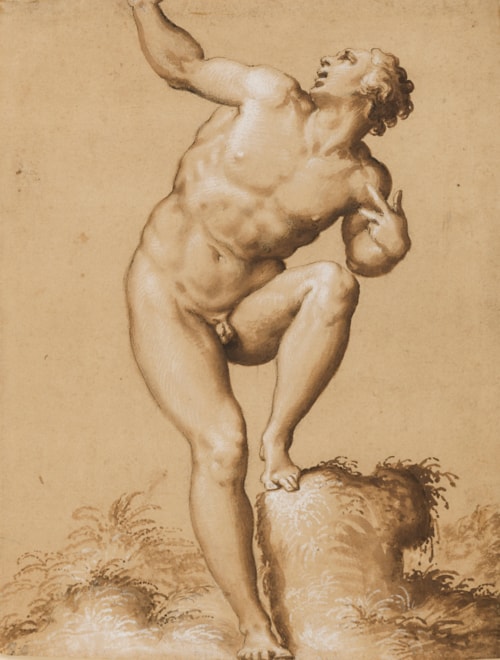
Francesco de'Rossi, called SALVIATI
Florence 1510 - Riome 1563
Biography
Francesco de’ Rossi studied for two years with Andrea del Sarto in Florence before settling in Rome in 1531 and entering the service of Cardinal Giovanni Salviati, from whom he took his name. His major work of this Roman period was a Visitation painted in 1538 for the Oratory of San Giovanni Decollato. He was back in Florence by 1539, working on the decorations to celebrate the marriage of Duke Cosimo I de’ Medici to Eleanora of Toledo. A trip to Venice between 1539 and 1541, where he painted two ceiling paintings for the Palazzo Grimani, was followed by a period spent in Rome serving as painter to Pierluigi Farnese. Back in Florence in 1543, he received his most important commission to date; the decoration of the Sala dell’Udienza in the Palazzo Vecchio for Cosimo I. The frescoes of the Sala, the Duke’s audience chamber, were painted by Salviati between 1543 and 1545 and established his reputation as a mural painter of the first rank. Its success led to further important commissions, and over the next several years in Rome he was engaged on the decoration of the Palazzo Farnese, the Palazzo della Cancelleria and, between 1549 and 1550, the Cappella della Pietà in the church of Santa Maria dell’Anima. Salviati’s last great decorative project was a fresco cycle of scenes from the story of David for the sala grande of the Palazzo Ricci-Sacchetti, commissioned by Cardinal Giovanni Ricci and begun in 1553. Apart from a short stay in Milan in 1554 and a brief trip to France in 1556-1557, the artist remained in Rome for the rest of his career.
Salviati was one of the most gifted draughtsmen of his generation, and was greatly admired as such by early biographers and contemporaries. Giorgio Vasari owned a number of his drawings, while the 16th century playwright and art critic Raffaello Borghini, writing not long after Salviati’s death, stated that his ‘drawings were held in very great esteem.’ Working in a variety of media and employing different techniques, Salviati made drawings not only as preparatory studies for painted works, but also as designs for prints, tapestries, book illustrations, majolica and other decorative arts. He also produced a number of drawn copies after works by other artists – including Raphael, Polidoro da Caravaggio and, in particular, Michelangelo – not only as a young student but throughout his career. Vasari, who knew Salviati well, notes that on his death the artist left his drawings to his pupil Annibale Lippi. Just over three hundred drawings by Salviati are known today, the largest groups of which are in the Uffizi in Florence and the Louvre in Paris.


